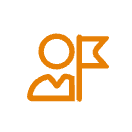Written by Catherine |
The Mid-autumn Festival, aka Moon Festival, is one of the four major traditional festivals in China, alongside the Spring Festival, Qingming Festival, and Dragon Boat Festival. It falls on the 15th day of the 8th lunar month, typically in September or early October. During the festival, a mix of traditions and activities are often organized, making it one of the best times to visit China to experience colorful celebrations. In 2025, the festival will happen on October 6th. Typically, people in mainland China can have a one-day public holiday to celebrate it.
Over the thousands of years of development and evolution, many elements of traditional Chinese culture have been intertwined with the Mid-autumn Festival. In 2006, the State Council listed it as a national intangible cultural heritage.
What is the origin of the Mid-Autumn Festival? Who celebrates the festival, how do people celebrate it, and what’s the story about it… This article will guide you through this traditional Chinese festival.
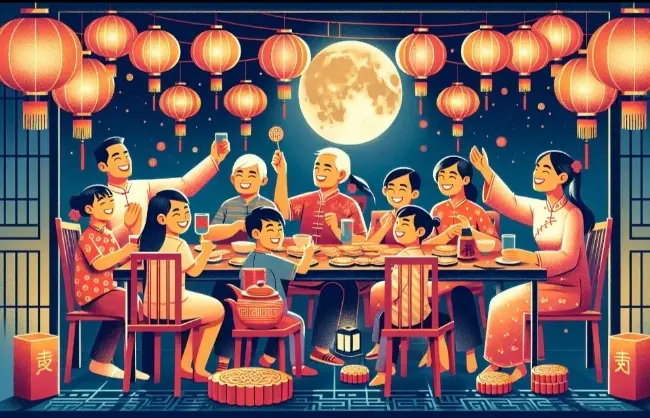
What is China’s Mid-autumn Festival?
The Mid-autumn Festival is an important time for family reunions, being celebrated annually on the 15th day of the eighth lunar month. The seventh, eighth, and ninth lunar months are the three autumn months, and the 15th day of the eighth month marks the midpoint of the autumn, and also the harvest time in the middle of autumn, hence the name “Mid-autumn”.
This day happens to be the day when the moon is at its fullest, symbolizing reunion and harmony. Thus arose the tradition for families and friends to gather together, enjoying meals and sharing mooncakes. In different areas, various customs and activities are also organized, such as admiring and worshipping the moon, praying for good fortune, carrying lanterns, honoring ancestors, and expressing longing for distant relatives and friends.
Not only in mainland China, the Mid-autumn Festival is also widely celebrated in many East and Southeast Asian countries and regions, and places all over the world where ethnic Chinese people live.
Other Names of the Mid-autumn Festival
Mid-autumn Festival in Chinese is Zhongqiu Jie (中秋节). Since lies on the full moon day, it is also called Moon Festival. And since the tradition of eating mooncakes on this day, many people also call it Mooncake Festival. It also has several other alternative names, most of which are related to the moon, its traditions and stories, such as:
- Harvest Moon Festival
- Reunion Festival
- Autumn Festival
- Moon-viewing Festival
When is the Mid-autumn Festival in China?
The Mid-Autumn Festival falls on the 15th day of the eighth month of the lunar calendar, from mid-February to early October in the Gregorian calendar. The Mid-Autumn Festival date on 2025 will be October 6.
Year |
Date |
Holiday |
2024 |
September 15 |
September 15-17 |
2025 |
October 6 |
October 6 |
2026 |
September 25 |
September 25-25 |
Is Mid-autumn Festival a Public Holiday?
Until 2008, the Mid-autumn Festival was designated as a public holiday in China’s mainland. Typically, if the festival coincides with a weekend, people can enjoy a three-day holiday, with the following Monday being given as a compensatory day off. If the festival falls on a Wednesday, people can enjoy a one-day holiday on that day only, with no adjustment for the weekend days. However, if the festival falls on a Tuesday or Thursday, a three-day holiday will be created by adjusting the previous or following weekend days.
In Taiwan, the festival is a one-day public holiday. No additional day off will be compensated if it coincides with a weekend.
Read More: 9 Days Private Taiwan Tour
In Hong Kong and Macau, a one-day public holiday is given on the day after the Mid-autumn Festival (the 16th day of the 8th lunar month). If it falls on a Saturday, no additional day off will be given.
In Singapore and Malaysia, the Moon Festival is still not a public holiday yet.
Mid-autumn Festival Origin & Development
There is no specific time or event for the origin of the Mid-autumn Festival. Actually, according to historical records, the festival gradually evolved through traditions, cultural development, and societal changes in various periods and dynasties in ancient China.
As early as the Zhou Dynasty, emperors had the tradition to practice moon worship and rituals during the autumn season to express their thanks to the moon for the harvest. Gradually, common people also adopted these ceremonies.
During the Han Dynasty, besides moon worship and rituals, it is popular among the common people to honor and care for the elderly and give “Xiongcu Cake” in the Mid-autumn or the beginning of autumn. There are also records of the practice of moon gazing in the Jin Dynasty in the Mid-autumn.
The Tang Dynasty is an important period for the integration and formalization of traditional festival customs. In its capital Chang’an, moon gazing during the Moon Festival is especially popular. The moon appeared in many famous poems and verses at this time. The festival was linked to many romantic moon-related legends, and Chang’e flying to the moon is the best-known one.
In the Northern Song Dynasty, the government officially designated the 15th day of the 8th lunar month as the Mid-autumn Festival. The festival became a grand celebration around the country and was highlighted by many activities. Family reunions overall became a significant aspect of the festival celebration during this period.
In the following Ming and Qing Dynasties, there was a greater emphasis on the significance of the Moon Goddess and bountiful harvest, with various seasonal fruits being offered during moon worship. The Moon Festival eventually became one of the four major traditional festivals in China.
Mid-autumn Festival Stories
As a traditional Chinese festival, the Mooncake Festival also carries rich mythology and legends. Below are some of the most classic ones:
Chang’e Flying to the Moon
This is the most famous legend associated with the Mid-autumn Festival. It is said that in ancient times, there were ten suns scorching the earth. To save the people from drought, the hero Hou Yi shot down nine suns. He was rewarded with an elixir of immortality. Since didn’t want to gain immortality without his wife, Hou Yi entrusted the elixir to his wife, Chang’e.
On a Mid-autumn Day, when Hou Yi was out hunting, Hou Yi’s apprentice tried to force Chang’e to hand over the elixir. In desperation, Chang’e swallowed the elixir and floated up to the Moon Palace. Heartbroken by her departure, Hou Yi would offer her favorite food every year on the 15th day of the 8th lunar month. This practice was gradually followed by common people, forming the moon worship custom during the Moon Festival.
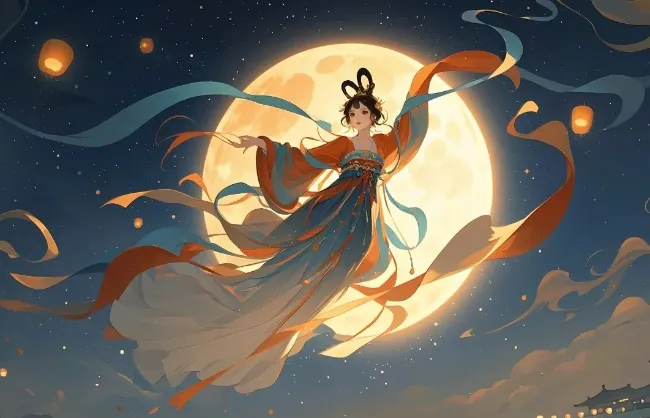
The Jade Rabbit Grinding Medicine
The Jade Rabbit is Chang’e’s companion in the Moon Palace. It is as white as jade and helps Chang’e to grind medicine and make elixirs of immortality. In Chinese culture, the Jade Rabbit is closely associated with the moon, representing people’s longing for immortality and a better life.
Wu Gang Chopping the Laurel Tree
According to the legend, Wu Gang made a mistake and was banished to the Moon Palace. The Heavenly Emperor published him to chop down the giant laurel tree in the Moon Palace. Magically, the tree can heal itself immediately after Wu Gang struck it. Year after year, Wu Gang continued chopping the tree and became an eternal figure in the Moon Palace.
Because of this legend, the moon is also referred to as the Laurel Moon. In some regions, people have the custom of admiring laurel flowers during the Mid-autumn Festival.
Related reading: Stories about the Spring Festival
How Do People Celebrate Mid-Autumn Festival: Traditions & Activities
Family Reunion
The Mooncake Festival is a great time for family reunions. The public holiday allows people to take a break from work and return home to spend the festival and enjoy a reunion dinner with their families and loved ones.
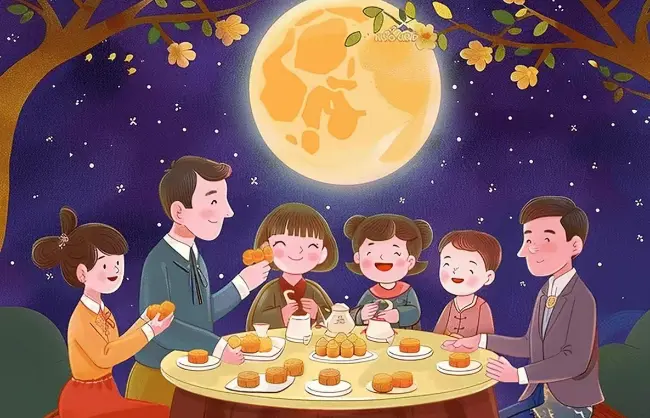
Moon Gazing
The full moon on the Moon Festival night is particularly round and bright, attracting people to admire its beauty. For the Chinese, the moon symbolizes reunion and completeness. While gazing at the moon, people express their longing and blessings for their family members.
Eating Mooncakes
As the most iconic Mid-autumn Festival food, mooncakes symbolize reunion and happiness. Eating mooncakes or sharing mooncakes with families is a can’t-miss activity while celebrating the festival. Different regions have different ways of flavoring mooncakes, and they thus come in various flavors and fillings, including lotus seed paste, red bean paste, mixed nuts, etc.
Moon Worship
In ancient times, people usually pray to the Moon Goddess for blessings, good harvest, and health on the festival night. This ancient custom has been maintained to this day. In Guangdong, Yunnan, Guangxi, and many other regions, people still set up offering tables and preparing food and seasonal fruits and nuts to worship the moon.
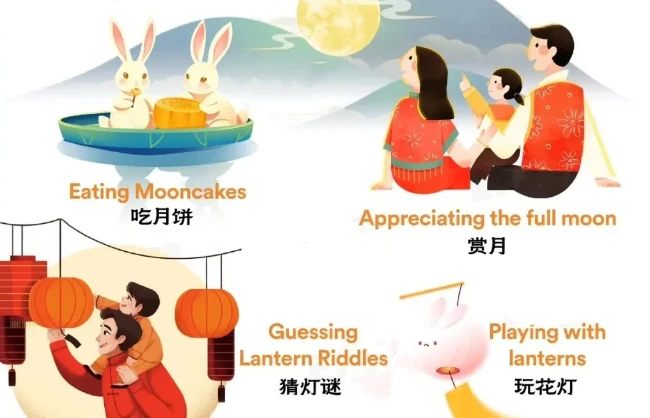
Lantern Lighting
On the night of the festival, people tie the lanterns to bamboo poles and hang them from eaves or balconies. This activity is called “Shu Zhongqiu”. In the Jiangnan regions, people also make lantern boats and watch the boats float away in the water. They believe the lanterns will carry their best wishes to distant places. In some regions, people often decorate lantern crafts with various characters and shapes and hang them under trees.
Tea Drinking
When Chinese tea culture intersects with the traditional Mid-Autumn Festival, the festival experience is further enhanced. The custom of drinking tea during the Moon Festival can be traced back to the Tang Dynasty. On the night of the festival, people would brew and drink “tuancha”, which is in a full moon shape, symbolizing reunion and completeness. Today, people still preserve this tradition while admiring the moon. The fragrance of tea pairs well with the sweetness of mooncakes.
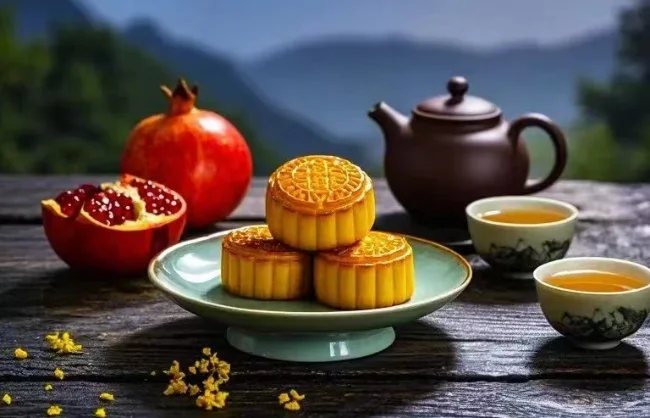
Other Mid-autumn Festival Activities
In different regions, various other Mid-autumn activities and traditions are still preserved to enhance the festive atmosphere. In Beijing, people have the custom of playing with the craft of “rabbit figurines”. In coastal areas, like Hangzhou, people often gather by the sea to watch the spectacular tides during the festival. In Taiwan and some ethnic areas of Hunan, unmarried women would steal vegetables on the festival night since it symbolizes good fortune and happiness.
Related reading: Traditional Chinese Customs to Celebrate Spring Festival
Mid-autumn Festival Food
Mooncakes – The Quintessential Food of the Mid-Autumn Festival
Mooncakes are also known as “reunion cakes”, serving as a symbolic food of the Mid-Autumn Festival. Since it is recognized as a symbol of good fortune and reunion, people like to send mooncakes to their relatives and friends during the festival and strengthen the bond with their loved ones.
Nowadays, there are mooncakes of different regional styles for people to choose. Each style features unique fillings, shapes, and preparation methods. For example, Beijing-style mooncakes are known for their flaky crusts, Cantonese-style mooncakes have both sweet and savory fillings, and the fillings of Suzhou-style mooncakes often include walnuts, sunflower seeds, pine nuts, osmanthus, and rose.

Other Typical Mid-autumn Festival Foods
- Ciba (Glutinous Rice Cake): In Sichuan and Chongqing regions, people would pound the glutinous rice with wooden sticks to make ciba for the festival.
- Hairy Crab: The Mooncake Festival coincides with the season for fat crabs, making the flavorful hairy crabs a popular dish on the reunion dinner table.
- Taro: August is the harvest season for taro, and its pronunciation is similar to “luck comes” in the local dialect.
- Glutinous Rice Stuffed Lotus Root: By filling the lotus root with glutinous rice and drizzling it with osmanthus syrup, the dish features a harmonious blend of fragrances and sweetness from different ingredients.
Related Reading: Chinese Lantern Festival – How to Celebrate, Origins, Food
Moon Festival Greetings & Wishes
Besides traditional celebrations and activities, many Chinese people now enjoy sending WeChat blessing messages and cards to friends and families during the Mid-autumn Festival to express good wishes. Below are some commonly used expressions, sayings and phrases for the festival:
- 中秋节 Zhōngqiūjié Mid-Autumn Festival
- 满月 mǎnyuè full moon
- 月饼 yuèbing mooncake
- 中秋快乐! Zhōngqiū kuàilè! Happy Mid-Autumn Festival!
- 祝您和您的家人中秋快乐 Zhù nín hé nín de jiārén Zhōngqiū kuàilè Wish you and your family a happy Mid-Autumn Festival
- 阖家团圆 héjiā tuányuán Family reunion and happiness
- 祝您中秋佳节快乐,月圆人圆事事圆满 Zhùnín Zhōngqiū jiājié kuàilè, yuè yuán rén yuán shì shì yuánmǎn Wishing you a happy Mid-Autumn Festival, may the full moon and family reunion bring you happiness and fulfillment in everything.
- 但愿人长久,千里共婵娟 Dàn yuàn rén chángjiǔ, qiānlǐ gòng chánjuān May we all live long; even though miles apart, we can share the beauty of the moon.
How Do Countries/Regions Aside from Mainland China Celebrate Moon Festival?
The Mid-autumn Festival is also celebrated in many countries and regions around the world. This includes Hong Kong, Taiwan, Macau, and neighboring countries deeply influenced by traditional Chinese culture, like Japan, and Singapore.
Mid-Autumn Festival in Hong Kong
In addition to traditional activities like eating mooncakes, admiring the moon, and family reunions, Hong Kong people also held many unique celebrations during the festival. Fire Dragon Dance, lantern exhibition, playing with lanterns, eating pomelos, and making pomelo lanterns are some of the most popular ones.
Mid-Autumn Festival in Macau
Visitors can expect a rich blend of traditional and modern activities in Macau during the Mid-Autumn Festival. Some popular traditional celebrations include lantern exhibitions, lion dance performances, moon gazing. While the unique modern celebrations are mid-autumn concerts, food exhibitions, light parties, and fairs offering traditional snacks, crafts, and lantern riddles.
Moon Festival in Taiwan
In Taiwan, besides traditional customs like moon gazing, eating mooncakes, and enjoying pomelos, people also celebrate the festival with barbecuing. This unique ritual sets the Taiwanese celebration apart from other places.
Mid-Autumn Festival in Japan
In Japan, it is called “Tsukimi” (月見), meaning “moon viewing festival”. Traditional activities during the festival include holding banquets while gazing at the moon, and enjoying “Kangetsusai”. Instead of mooncakes, the iconic Mooncake Festival food in Japan is “Tsukimi Dango”, a kind of glutinous rice dumpling.
Mooncake Festival in Singapore
With Chinese occupying about 75% of its population, Singapore also celebrates the Mid-autumn Festival. The Singaporeans celebrate the festival by eating mooncakes, carrying lanterns, moon gazing, and various festive activities, such as boating riding on the river, and lion dance performances.
More Chinese Culture-related Articles
- Chinese Zodiac: Everything You Need to Know
- Taoism, Tai chi and Yin-yang
- Guizhou Ethnic Festivals: the Best Minority Culture Experiences in China
If you’re planning a China tour during the Mid-autumn Festival, don’t miss the amazing autumn destinations in China.




